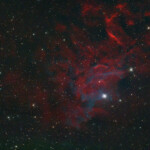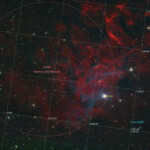IC 405 (also known as the Flaming Star Nebula, SH 2-229, or Caldwell 31) is an emission and reflection nebula in the constellation Auriga north of the celestial equator, surrounding the bluish, irregular variable star AE Aurigae. It shines at magnitude +6.0. Its celestial coordinates are RA 05h 16.2m dec +34° 28′. It is located near the emission nebula IC 410, the open clusters M38 and M36, and the K-class star Iota Aurigae.
The nebula measures approximately 37.0′ x 19.0′, and lies about 1,500 light-years away from Earth. It is believed that the proper motion of the central star can be traced back to the Orion’s Belt area. The nebula is about 5 light-years across.
![IC 405 (also known as the Flaming Star Nebula, SH 2-229, or Caldwell 31) is an emission/reflection nebula[1] in the constellation Auriga, surrounding the bluish star AE Aurigae. It shines at magnitude +6.0. It surrounds the irregular variable star AE Aurigae and is located near the emission nebula IC 410, the open clusters M38 and M36, and the naked-eye K-class star Hassaleh. The nebula measures approximately 37.0' x 19.0', and lies about 1,500 light-years away. It is believed that the proper motion of the central star can be traced back to the Orion's Belt area. The nebula is about 5 light-years across.
Photographed with CPC925 reflector telescope and Nikon D800 camera in Åva, February 2016. 4*90s exposure. IC 405, Flaming star nebula](https://astro.hal1.se/wp-content/uploads/cache/2023/03/ic405_flaming_star_nebula_4st_90s_neb2/1849792595.jpg)
IC 405, Flaming star nebula
IC 405 (also known as the Flaming Star Nebula, SH 2-229, or Caldwell 31) is an emission/reflection nebula[1] in the constellation Auriga, surrounding the bluish star AE Aurigae. It shines at magnitude +6.0. It surrounds the irregular variable star AE Aurigae and is located near the emission nebula IC 410, the open clusters M38 and M36, and the naked-eye K-class star Hassaleh. The nebula measures approximately 37.0′ x 19.0′, and lies about 1,500 light-years away. It is believed that the proper motion of the central star can be traced back to the Orion’s Belt area. The nebula is about 5 light-years across.
Photographed with CPC925 reflector telescope and Nikon D800 camera in Åva, February 2016. 4*90s exposure.

IC 410 and IC405, Flaming star nebula
IC 405 (also known as the Flaming Star Nebula) is an emission and reflection nebula in the constellation Auriga north of the celestial equator, surrounding the bluish star AE Aurigae. It shines at magnitude +6.0. It surrounds the irregular variable star AE Aurigae and is located near the emission nebula IC 410, the open clusters M38 and M36, and the K-class star Iota Aurigae.
The nebula measures approximately 37.0′ x 19.0′, and lies about 1,500 light-years away from Earth. It is believed that the proper motion of the central star can be traced back to the Orion’s Belt area. The nebula is about 5 light-years across.
NGC 1893 is an open cluster in the constellation Auriga. It is about 12,400 light years away. The star cluster is embedded in the HII region IC 410.
Images of the star cluster by the Chandra X-ray Observatory suggest that it contains approximately 4600 young stellar objects.
Photographed with APO94 refractor and ASI 2600MC color camera in Stuvsta, January 2022. 29*3min exposure with IDAS LPS P3 light pollution filter.

IC 410 and IC405, Flaming star nebula
IC 405 (also known as the Flaming Star Nebula) is an emission and reflection nebula in the constellation Auriga north of the celestial equator, surrounding the bluish star AE Aurigae. It shines at magnitude +6.0. It surrounds the irregular variable star AE Aurigae and is located near the emission nebula IC 410, the open clusters M38 and M36, and the K-class star Iota Aurigae.
The nebula measures approximately 37.0′ x 19.0′, and lies about 1,500 light-years away from Earth. It is believed that the proper motion of the central star can be traced back to the Orion’s Belt area. The nebula is about 5 light-years across.
NGC 1893 is an open cluster in the constellation Auriga. It is about 12,400 light years away. The star cluster is embedded in the HII region IC 410.
Images of the star cluster by the Chandra X-ray Observatory suggest that it contains approximately 4600 young stellar objects.
Photographed with APO94 refractor and ASI 2600MC color camera in Stuvsta, January 2022. 29*3min exposure with IDAS LPS P3 light pollution filter.

IC 410 and IC405, Flaming star nebula
Flaming star nebula IC 405 and reflection nebula IC 410 around the open cluster NGC 1893 (top).
30*3min exposure with ASI 2600MC camera, APO 94mm refractor telescope, and IDAS NB1 filter at about 15 degrees from full moon. First picture where autofocus worked flawlessly! Photo in Stuvsta, December 2021.
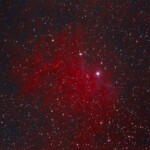
IC 405, Flaming star nebula
Photographed with APO107 refractor telescope and Atik 360EX monochrome CCD camera in Åva, March 2017
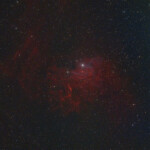
IC 405, Flaming Star Nebula
Photographed with the APO 107 mm refractor telescope and the ASI 2600MC color CMOS camera in Stuvsta, November 23rd, 2024. Exposure was 33 * 2 min with IDAS LPS P3 filter. No Moon, but very poor seeing duing to a low temperature of -8 centigrades and high humidity.
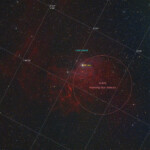
IC 405, Flaming Star Nebula
Photographed with the APO 107 mm refractor telescope and the ASI 2600MC color CMOS camera in Stuvsta, November 23rd, 2024. Exposure was 33 * 2 min with IDAS LPS P3 filter. No Moon, but very poor seeing duing to a low temperature of -8 centigrades and high humidity.
